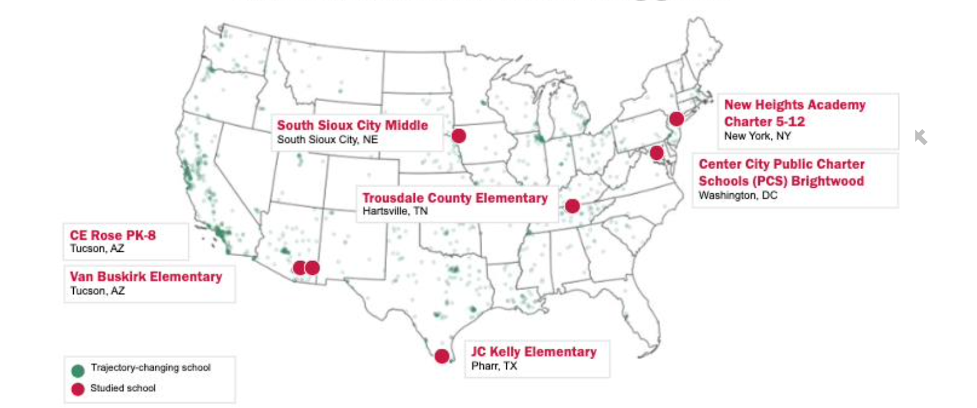The Habits of 7 Highly Effective Schools

“There are many schools that are effective at helping students learn, even in high-poverty communities,” said Sean Reardon, a Stanford sociologist who was part of the team that developed the Stanford Education Data Archive. “The TNTP report uses our data to identify some of them and then digs in to understand what makes them particularly effective. This is exactly what we hoped people would do with the data.”
TNTP did identify seven of the 1,345 highly effective schools that it selected to study in depth. Only one of the seven schools had a majority Black population, reflecting the fact that Black students are underrepresented at the most effective schools.
The seven schools ranged widely. Some were large. Some were small. Some were city schools with many Hispanic students. Others were mostly white, rural schools. They used different instructional materials and did a lot of things differently, but TNTP teased out three traits that it thought these schools had in common.
Seven of the 1,345 schools where students started behind but made large learning gains over a decade from 2009 to 2018

“What we found was not a silver-bullet solution, a perfect curriculum, or a rockstar principal,” the report said. “Instead, these schools shared a commitment to doing three core things well: they create a culture of belonging, deliver consistent grade-level instruction, and build a coherent instructional program.
According to TNTP’s classroom observations, students received good or strong instruction in nine out of 10 classrooms. “Across all classrooms, the steady accumulation of good lessons—not unattainably perfect ones—sets trajectory-changing schools apart,” the report said, contrasting this consistent level of “good” with its earlier observation that most U.S. schools have some good teaching, but there is a lot of variation from one classroom to the next.
In addition to good instruction, TNTP said that students in these seven schools were receiving grade-level content in their English and math classes although most students were behind. Teachers in each school used the same shared curriculum. According to the TNTP report, only about a third of elementary school teachers nationwide say they “mostly use” the curriculum adopted by their school. At Trousdale County Elementary in Tennessee, one of the exemplar schools, 80 percent of teachers said they did.
While many education advocates are pushing for the adoption of better curriculum as a lever to improve schools, “It’s possible to get trajectory-changing results without a perfect curriculum,” TNTP wrote in its report.
Teachers also had regular, scheduled sessions to collaborate, discuss their instruction, and note what did and did not work. “Everyone holds the same high expectations and works together to improve,” the report said.
The schools also gave students extra instruction to fill knowledge gaps and extra practice to solidify their skills. These extra support classes, called “intervention blocks,” are now commonplace at many low-income schools, but TNTP noted one major difference at the seven schools they studied. The intervention blocks were connected to what students were learning in their main classrooms. That requires school leaders to make sure that interventionists, classroom aides and the main classroom teachers have time to talk and collaborate during the school day.
These seven schools all had strong principals. Although many of the principals came and left during the decade that TNTP studied, the schools maintained strong results.
The seven schools also emphasized student-teacher relationships and built a caring community. At Brightwood, a small charter school in Washington, D.C., that serves an immigrant population, staff members try to learn the names of every student and to be collectively responsible for both their academics and well-being. During one staff meeting, teachers wrote more than 250 student names on giant pads of paper. Teachers put check marks by each child they felt like they had a genuine relationship with and then brainstormed ways to reach the students without checks.
At New Heights Academy Charter School in New York City, each teacher contacts 10 parents a week—by text, email, or phone—and logs the calls in a journal. Teachers don’t just call when something goes wrong. They also reach out to parents to talk about an “A” on a test, academic improvement, or good attendance, the report said.
It’s always risky to highlight what successful schools are doing because other educators might be tempted to just copy ideas. But TNTP warns that every school is different. What works in one place might not in another. The organization’s advice for schools is to change one practice at a time, perhaps starting with a category that the school is already pretty good at, and improve it. TNTP warns against trying to change too many things at once.
TNTP’s view is that any school can become a highly effective school, and that there aren’t particular educational philosophies or materials that a school must use to accomplish this rare feat. A lot of it is simply about increasing communication among teachers, between teachers and students, and with families. It’s a bit like weight-loss diets that don’t dictate which foods you can and cannot eat, as long as you eat less and exercise more. It’s the basic principles that matter most.
Contact staff writer Jill Barshay at (212) 678-3595 or barshay@hechingerreport.org.



